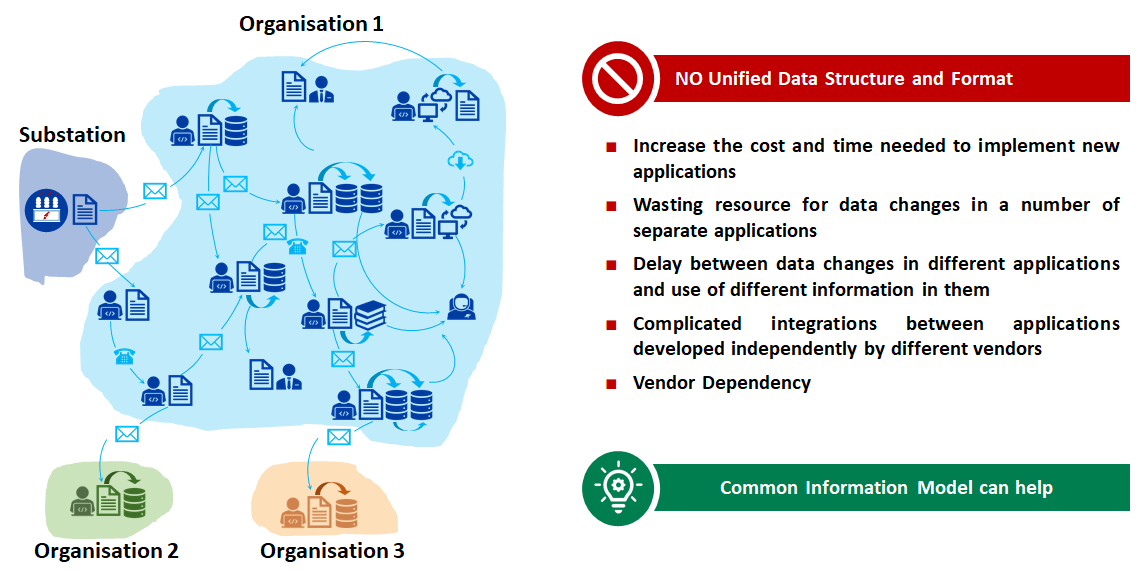CIM methodology
Introduction
The extensive growth of digitalization has resulted in development and implementation of numerous applications and systems used by utilities. All of these applications and systems require data to be used to model the electric grid, generating facilities, operations and planning as well as business functions, different services, maintenance and markets. Integration of large number of applications and systems is a complex task, especially if the models in use have conceptual differences and different granularity.

Figure 1 – Information exchange without integration
The use of Common Information Model (CIM) described in the international standards IEC 61970, IEC 61968, IEC 62325 makes it easier to integrate applications and systems. The CIM standards provide an abstract information model that represents all the major objects of an electric utility and describes general modelling approaches including common profiles and formats.
The IEC 61970 series defines application program interfaces (APIs) for an energy management system (EMS). These standards and requirements focus on the integration between applications and systems used in control centres as well as their integration with the external environment (TSO, DSO, plant, consumer). The Common information model described in IEC 61970 series includes objects which could represent the overall interconnected electric grid required for operation and planning processes.
The IEC 61968 series defines APIs for a distribution management system (DMS). The IEC 61968 specifies the CIM for different business functions including asset management, work management, meter reading and control, geographical location and customer information.
The IEC 62325 series is referred to information exchange for electricity market business processes and includes extensions for forecasting, bidding, clearing, etc.
As the CIM represents highly detailed power system model, it could be relevant for numerous tasks and applicable for integration of numerous applications and systems used in variety of business process by power utilities.
The Common Information Model semantics is defined using object-oriented modeling and expressed in Unified Modeling Language (UML) notation which is platform-independent. The objects are represented as classes with attributes and relationships to other classes such as generalization, association, aggregation. The CIM objects are grouped into packages, each associated with another package. There are core, topology, wires, protection and other packages which describe different domains.
As a common format for describing profiles for data exchange, the IEC has proposed CIM RDF Schema presented in IEC 61970-501 standard. CIM RDF Schema represents the metamodel framework for building power system models as XML documents, also called CIMXML (CIM RDF XML) format described in IEC 61970-552 standard.
The expected positive results from the use of CIM technologies could be considered as the following:
- to reduce the cost and time needed to implement new applications;
- to improve integrations between applications developed independently by different vendors;
- to protect the investment in existing applications that work effectively;
- to save resources for data changes in a number of separate applications;
- to reduce the delay between data changes in different applications and use of similar information in them.
At the moment, many companies use the CIM standards for various areas, including:
- Operational planning;
- Long-term planning;
- Asset Management;
- Electricity market, etc.
The survey provided in 2022 by the Association of the Very Large Power Grid Operators (GO-15) shows that 8 of 11 GO-15 Operators-members use the Common Information Model for information exchange within a company and 7 of 11 use it for information exchange between different companies. The survey also shows that 7 of 11 companies use extended AC line model, which is included in the scope of the study.
Despite the CIM representation of highly detailed power system model, for some tasks it demands to be extended. The extensions could range from adding new attributes or associations to existing classes to adding new classes and even new packages. The latter could be required if a new domain is being considered. One of the examples of such an extension is IEC 61970-301 Annex A, which describes a package containing the European extensions to Base package. Similar model extensions could be widely used in different companies and countries.
Working Group Aim and Scope
The WG D2.57 “CIM methodology” aims to help with the analysis of existing extensions of the standard model, as well as proposals for their unification or for the creation of new extensions to ensure the possibility of solving more tasks. The extensions proposed by the WG will be free of any patent.
Preliminarily, the WG will work on the following issues:
- Identification of the current scope and granulation for equipment models and its relevance for various tasks.
- Benchmark of the scope of information models of the most common EMS and DMS applications.
- Development of extended AC line model to provide flexibility of modelling and solving variety of tasks.
- Development of power transformer model extensions.
- Development of other extensions according to the results of collecting information about companies’ needs (e.g. relay protection model).
- Availability of UML models for the proposed extensions.
The WG will aim to publish technical brochures and tutorials and review the current status of issues mentioned above. The WG welcome the participation and support from experts worldwide to promote the development of modern digital power systems.

